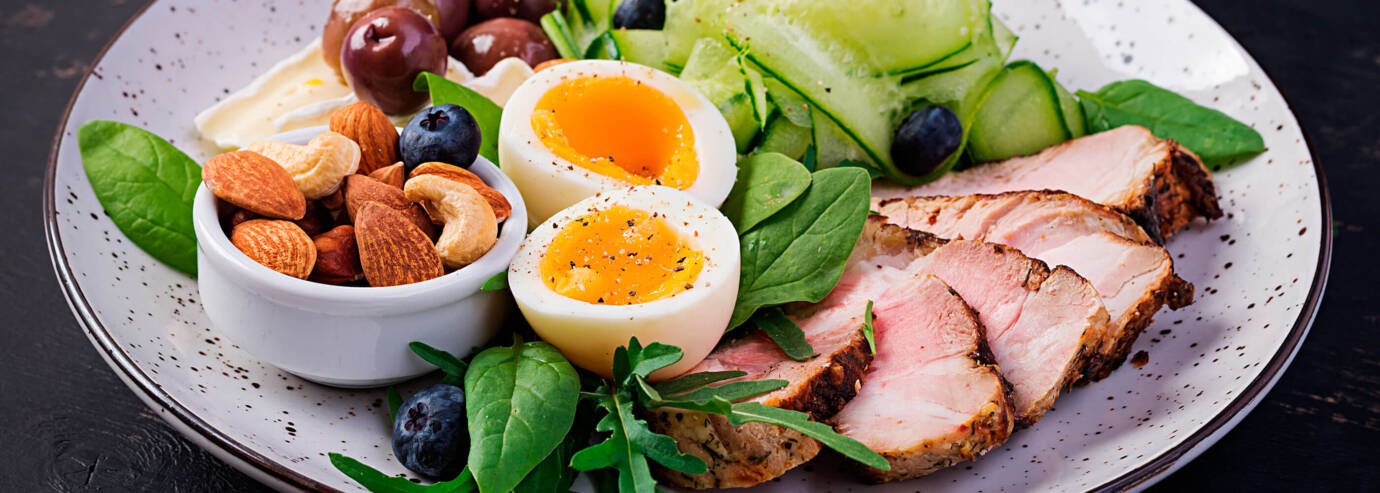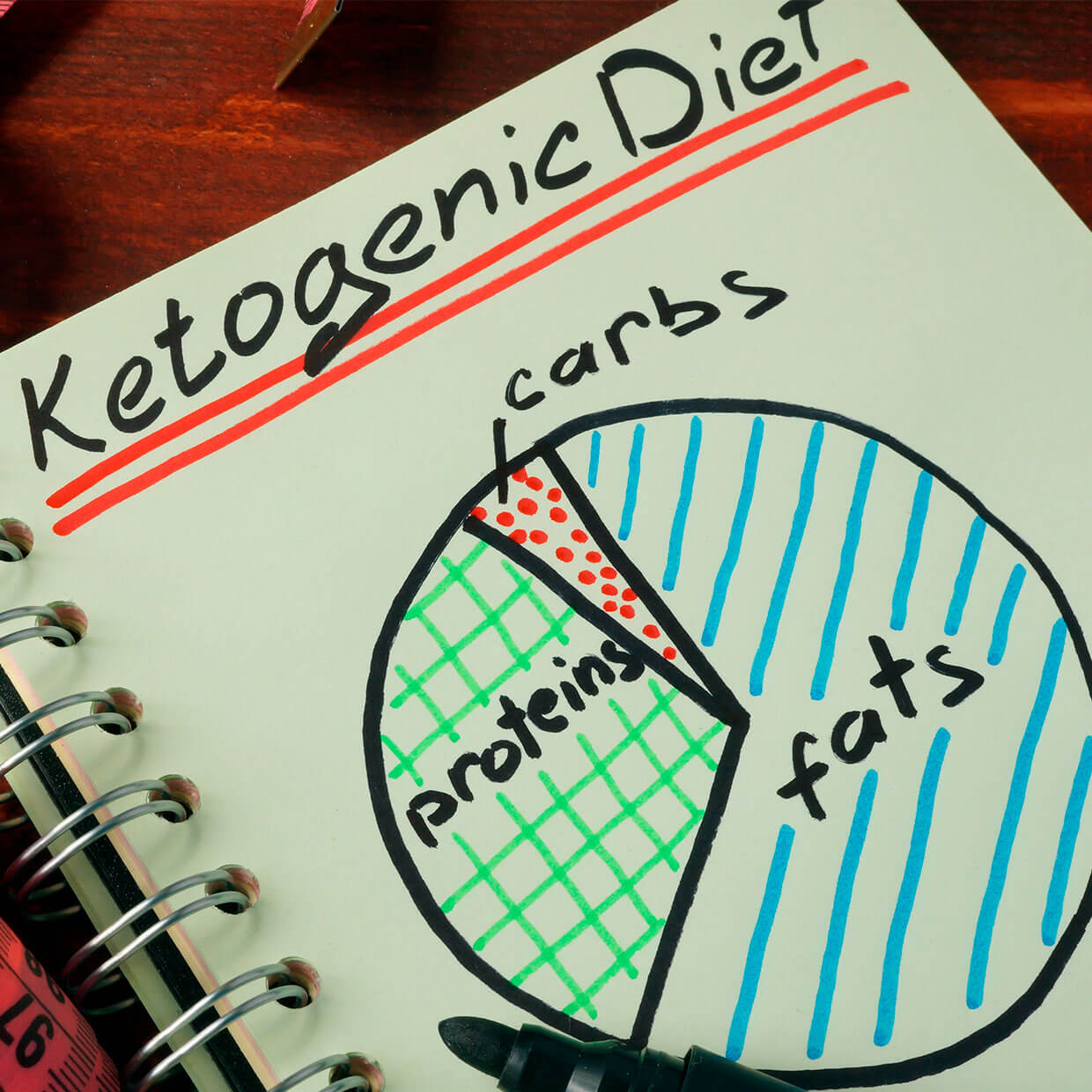Ketogenic diet

A ketogenic diet is an extreme form of low-carb dieting. Low-carb means that we consume very few carbohydrates, while a ketogenic diet reduces carbohydrate intake to an absolute minimum.
The menu for this diet therefore primarily contains fats and proteins. The reason is that if we abstain from eating fruit, vegetables and grains, we miss out on “quick” sources of energy. Our bodies get the sugar needed for our organs from its fat reserves, thereby achieving ketosis.
The feeling of satiety last longer and we lose weight in the long-term. This is ultimately the main reason why many people decide to follow a ketogenic diet.

How does a ketogenic diet work?
If we adhere to a healthy, «normal» diet, we consume on average:
- 50 percent carbohydrates
- 30 percent fats
- 20 percent proteins
In a ketogenic diet, the fat and protein content is increased, while the intake of carbohydrates is reduced massively. In figures, this means:
- 5 percent carbohydrates
- 20 percent proteins
- 75 percent fats
A ketogenic diet takes advantage of the existing mechanisms in our body. This unusual diet follows the goal of achieving what is known as ketosis.
What is ketosis?
Our bodies generally take the glucose from the carbohydrates we eat and convert them into energy. If we avoid consuming carbohydrates, such as during a ketogenic diet, we require an alternative source of energy, one we can find in fat. As soon as the body has used its glucose reserves and is gaining energy solely from fat cells, we have reached a state known as ketosis. This enables us to lose fat quickly, thereby losing weight too.
To remain in a state of ketosis, you must take the rules for ketogenic nutrition very seriously. Unlike other diets, this one doesn’t allow even a single cheat day. You basically keep a diary of every aspect of your diet and must precisely weigh all food.
The amount of carbohydrates is not the only major factor. You must also keep an eye on the amount of proteins, too. If you eat too many of them, the amino acids contained within are converted to glucose, which in turn inhibits the formation of ketone bodies. Ketone bodies are important for the brain metabolism, as they help the brain manage to get by with less glucose than it is used to.
What can I eat?
Fats are at the centre of a ketogenic diet. They make up 75 percent of the food we eat each day. If you decide to follow a ketogenic diet, please make sure to consume healthy fats.
The following foods contain fats which are preferred in ketogenic diets
- Avocado
- Butter
- Chia seeds
- Ghee
- Hemp oil
- Cocoa butter
- Cold-pressed olive oil
- Coconut oil
- Linseed oil
- Linseed
- Walnut oil
When following this diet, you should strictly avoid processed foods and oils with poor fatty acid profiles, such as sunflower oil, peanut oil or margarine.
The following protein sources are ideal for a ketogenic diet:
- Eggs
- Low-carbohydrate dairy products
- Fatty fish
- Meat
- Whey protein
- Soy
Fried bacon and friends are ketogenic, but they do not contain any valuable fats and nutrients. You can practise abstaining here.

Green, low-carb vegetables, such as spinach, lettuce, courgettes, cucumber or celery are great for a keto diet, while legumes, such as beans, chick peas and potatoes are not suitable. Selecting fruit depends on the fructose content. Eat lemons, blackberries, guava, raspberries and blueberries, and leave the bananas, strawberries, plums and apples in the fruit basket due to their carbohydrates.
Foods with high amounts of carbohydrates, such as sugar or grains (rice, corn or wheat) are not part of a ketogenic diet. Neither are soft drinks or energy drinks, fruit juices and other beverages sweetened with sugar.
Stevia has become a popular sweetener amongst followers of keto diets – so why not try our Stevia products? We have a huge selection!
Is a ketogenic diet suitable for me?
If you have diabetes or kidney problems, you should avoid the extreme versions of a ketogenic diet. Other than that, theoretically anyone can switch to ketogenic nutrition. However, you should be aware that as well as extensively avoiding carbohydrates, this diet requires considerable discipline and enormous effort to start with. Planning meals, weighing ingredients, monitoring macronutrients (nutrients which provide our bodies with energy), consistently sticking to the diet plan – all to achieve ketosis and remain in that state. We recommend that you first check your habits and behaviour and then decide whether a ketogenic diet is for you.
Vegan and keto diet?
Fats and proteins make up the majority of a keto diet. As such, the selection of foods is quite limited for vegans. However, it is not impossible. Quinoa, soy, buckwheat or lentils are potential sources of proteins and are suitable parts of a keto diet. We recommend you use a suitable app which records foods and their compositions, making meal planning significantly easier.
How long does a keto diet last?
Your metabolism will change as part of the diet, and it therefore takes three to four days before your body reaches ketosis. Until then, the only way is to keep going! Once your body has achieved the state of ketosis, you can theoretically pursue this diet as long as you want.
Practically, however, the one-sidedness of a keto diet often results in risks related to resulting deficiencies. Specialists therefore recommend taking a break in between, so that your body does not «forget» how to metabolise glucose. If your plan is to follow a ketogenic diet for an extended period of time, we recommend you consult with a doctor.